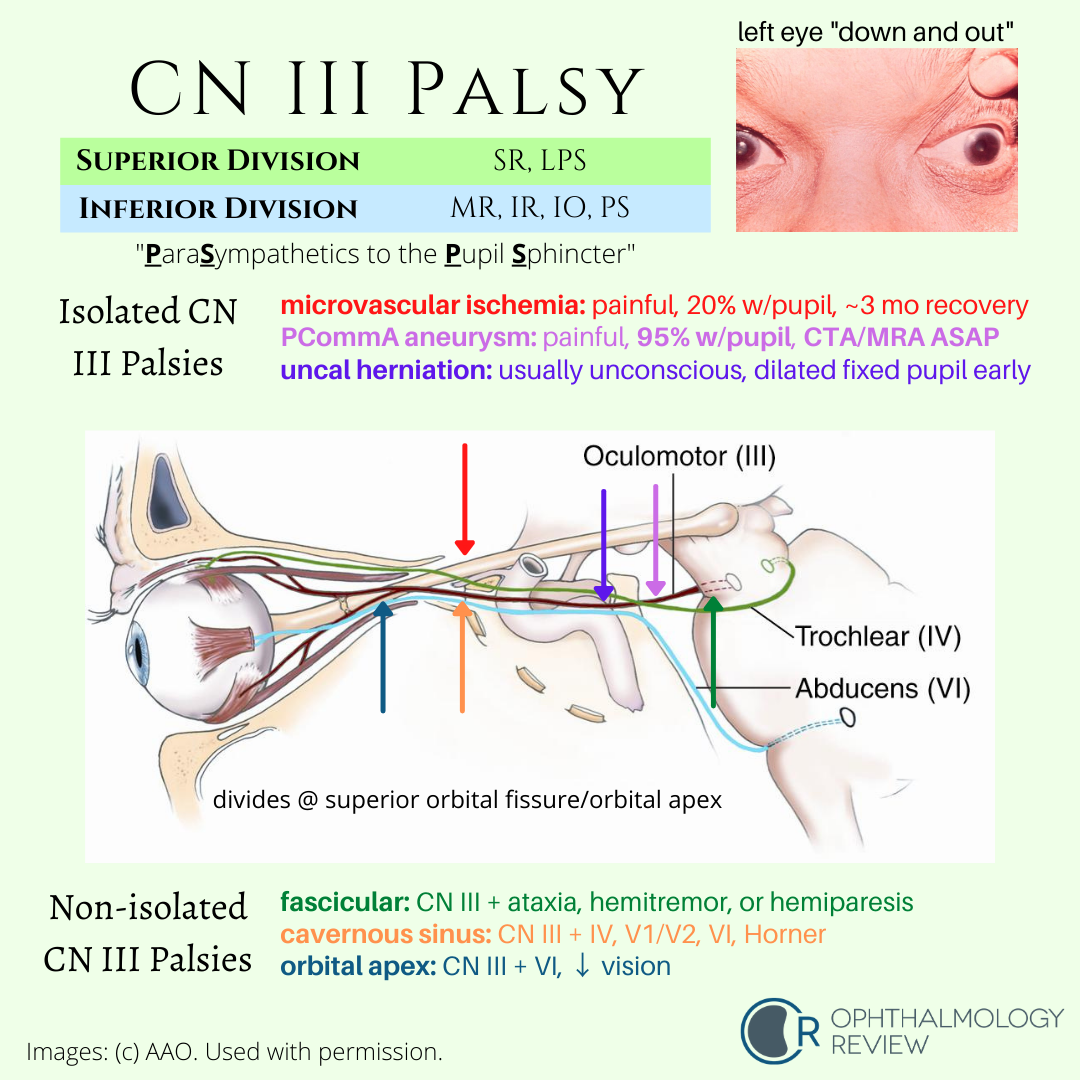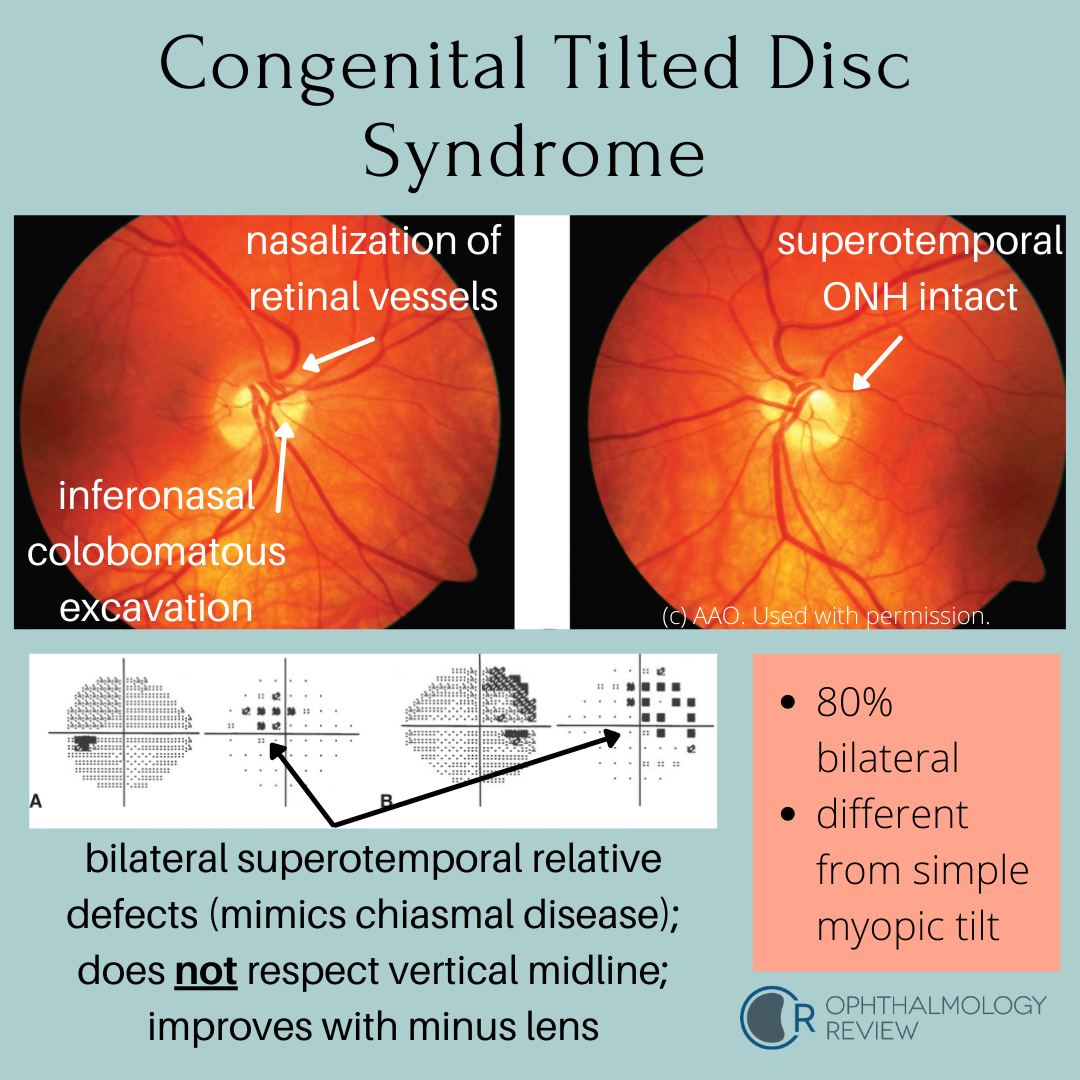The Preferred Practice Pattern guidelines for diabetic retinopathy have a really useful table that has helped me figure out the recommended follow-up schedule for patients with diabetic retinopathy. However, that table can sometimes be difficult to conceptualize, so as part of my quest to improve my design skills, I’ve segmented the follow-up periods over the course of a year and used some colors and hierarchy to provide a more visually dynamic presentation.
Papilledema (Coffee Table Book Page)
I’ve been learning more about graphic design as I hope to improve my abilities to communicate and teach. One of my self-assigned “homework” assignments was to imagine a textbook designed as a “coffee table” book. You can download this page as a PDF for free below! If you’d like me to make more documents like this, send me an e-mail or reach out to me on social media!
Localization of Third Nerve (CN3) Palsies
Understanding the associated and not-associated features of CN3 palsies can help localize the disease. Because partial CN3 palsy is often associated with other life-threatening or highly-morbid disease, urgent neuroimaging is recommended in all cases of suspected partial CN3 palsy.
Optic Pit
This is a condition that can mimic glaucoma due to the temporal excavation and paracentral or arcuate visual field defects. Serous retinal detachments are fairly common in these cases.
Superior Segment Hypoplasia (Topless Disc Syndrome)
This condition may be mistaken for glaucoma due to the inferior arcuate visual field defect and RNFL thinning on OCT. On exam there is no cupping of the optic nerve (usually), and the superior half of the optic nerve is missing or sometimes looks “lopped off,” leading to the name “topless disc syndrome.” The key question that should be asked in the medical history is if the patient’s mother has diabetes mellitus. Unlike glaucoma, this condition does not need treatment.
Morning Glory Disc Anomaly
Like optic pits, morning glory disc anomalies have a risk of serous RDs. Neuroimaging is indicated at initial diagnosis of morning glory disc anomaly to evaluate for basal encephaloceles and CNS vascular anomalies such as moyamoya disease.
Congenital Tilted Disc Syndrome
This condition mimics early bitemporal hemianopia; as such, these patients often get MRIs to look for chiasmal disease. Because these depressions are relative due to refractive error (colobomatous excavation) and not absolute, it’s worth trying different lenses to see if the defects resolve - a compressive lesion such as a pituitary macroadenoma would not improve with different lenses.
Optic Nerve Hypoplasia
Horner Syndrome: Pharmacologic Diagnosis
Horner syndrome describes the constellation of findings associated with a lesion affecting the oculosympathetic pathway. Clinically, ipsilateral miosis, ptosis, and anhidrosis form the classic triad, with other features potentially being present.
Without getting into too much detail about the sympathetic pathways and differential diagnosis of Horner syndrome (those will be covered in other articles), I will attempt to highlight the 3 pharmaceutical agents used in the diagnosis of Horner syndrome, discuss the tests, and point out the key ideas that often find themselves in tests.
Glaucoma Genetics
Hydroxychloroquine And Chloroquine Screening (2016 AAO Recommendations)
The American Academy of Ophthalmology released an updated set of screening recommendations for hydroxychloroquine (Plaquenil) and chloroquine to account for the many studies that have shown the effects of these medications on the retina (1). It succinctly makes the case for screening, and outlines the evidence for screening methods and parameters to know for screening.
Conditions Associated With Congenital Nystagmus: The 4 A's
There are many different eye conditions that are associated with congenital nystagmus; theoretically, any bilateral visually-significant pathology present at birth or in infancy during the critical period of visual development may interfere with the development of stable fixation (1) Eventually I'll get around to discussing the finer points of nystagmus; but for now, I'm sticking to some basic study stuff.
Diagnostic Criteria For Pseudotumor Cerebri (Idiopathic Intracranial Hypertension)
Pseudotumor cerebri syndrome (PTC, also referred to as idiopathic intracranial hypertension [IIH]) is classically taught as presenting in young, overweight women of childbearing age, with a history of headaches and findings of bilateral optic nerve swelling, associated with an elevated intracranial pressure. However, as with every "textbook" definition of a disease, there are atypical cases (children, men, thin people, older people), and so I am often confronted with some interesting diagnostic challenges when I am referred a patient that does not fit the typical picture of PTC who has bilateral optic nerve swelling.
Phakomatoses: Overview
Phakomatoses are a multidisciplinary category of systemic diseases that is often tested for a multitude of reasons. Although the incidence of these conditions is fairly low (though chances are you will see at least 1 case of many of these conditions), there are many ocular findings that need to be considered.
I've been debating how to organize this information in a useful manner for review for quite some time. The subject material is pretty massive, and each condition could easily take several articles (and probably eventually will). But I wanted to make sure there was a useful review out there on this subject before the written board exam, in case the test covers one of these conditions.
Follicular Conjunctivitis
Fetal Alcohol Syndrome
In light of the Centers for Disease Control's very broad statements about alcohol use in women, perhaps this topic is somewhat appropriate. Like I alluded to in the OKAP review article on embryology, there are many ocular findings associated with fetal alcohol syndrome, which are important to know, both for clinical recognition, and also for ongoing monitoring. For further reference, the CDC has a pretty useful web portal on fetal alcohol spectrum disorders.
Congenital Optic Disc Anomalies
Funny-looking optic discs are a "fun" diversion in an ophthalmology clinic (sarcasm implied here). What was initially a routine exam immediately turns into an agonizing "is this normal or not" exercise. Part of the angst that comes from seeing anomalous optic discs is that some of the congenital disc anomalies are associated with systemic diseases. If there is concurrent visual field loss or decreased visual acuity, the challenge becomes deciding if those defects in the visual system are due to the anomalous nerve, or if there is some other ophthalmic cause that we don't want to miss.
Optociliary Shunt Vessels
Optociliary shunt vessels (retinochoroidal shunts), are normal congenital collaterals between the retinal and choroidal venous circulation. In conditions that cause chronic central retinal vein obstruction, venous outflow becomes redirected to the choroidal venous circulation, resulting in dilation of these collateral vessels.
Papilledema
Lacrimal Gland Tumors
To be honest, I wasn't completely sure whether to categorize this topic under oculoplastics or ophthalmic pathology. Arguments definitely could be made for either, or both.
In any case, there are 3 major tumors that affect the lacrimal gland: orbital lymphoma, pleomorphic adenoma of the lacrimal gland, and adenoid cystic carcinoma of the lacrimal gland. If you see a test question about a tumor of the lacrimal gland, it is going to be one of those three conditions (probably).










